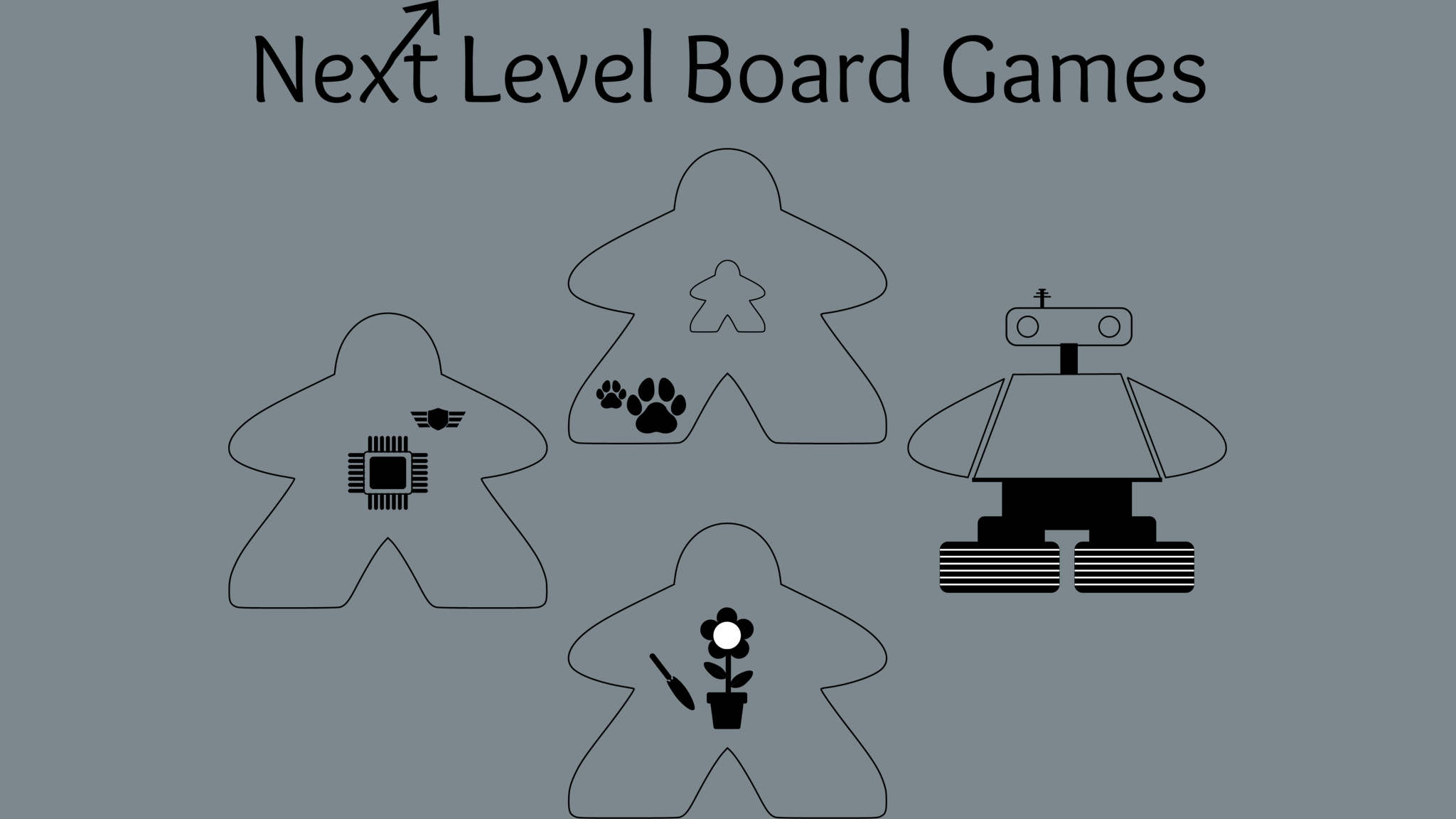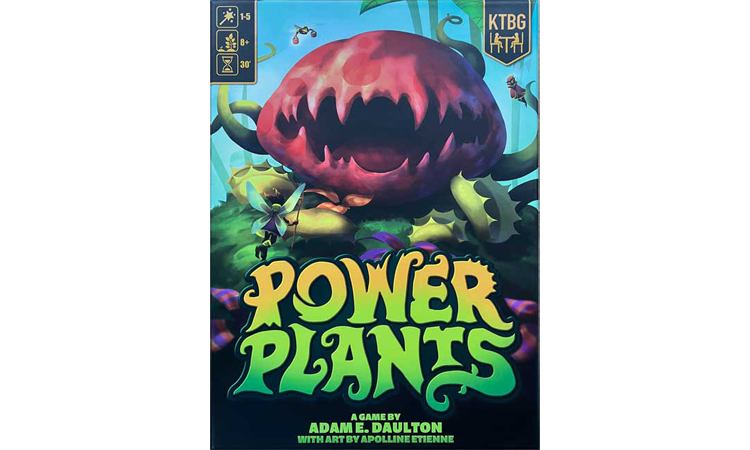Power Plants is a game published by Kids Table Board Gaming. The premise of the game is for players to take on the role of wizard working to controlling the best field in the garden. To accomplish this, players add patch tiles to the garden and choose between activating that tile's greater power, or activating the weaker powers of all adjoining plant tiles. When the last patch tile is drawn from the tile bag, the end of game is triggered and after all scoring, the player with the most gems is declared the winner.
To see what is included in this game, watch our unboxing video:
This post is broken into the following 3 sections, feel free to jump directly to one:
- General summary - consisting of information about overall enjoyment, theme, replayability, and upgrades
- Complexity - consisting of information about the rulebook, setup, player turns, and overall learning curve
- Player turns - consisting of game type, game flow, rule you are likely to miss, and favorite aspect
General Summary
Number of players we had: 4
Our play time (not including setup): 1 hour 20 minutes
Table size needed: Medium (5')
Special considerations: The colors of some of the patch tiles are very similar, you may want to be careful which ones you choose for each game if you have anyone with color blindness. The sprites are very different colors and should not pose any issues. While the sprites are very small, anyone with dexterity issues should be okay because of their unique shapes and edges that make them easier to pick up.
Overall enjoyment

Overall we enjoyed playing this game for several reasons. Some of the things we enjoy are the plant theme with the cute, unique sprites. We also like the different ways you can go about earning gems, which help you win the game, and the different benefits provided by each plant type.
In Power Plants players take on the role of wizards trying to create the greatest fields, meaning being in control of those areas by deploying the most sprites. Each player has 20 sprites in a custom color and shape. While there are 10 different types of plants, each with two versions, only 5 plants are used each game which increases the replayability.
One their turn, players plant a new patch into the garden by adding a tile next to an existing patch(es). Once placed, the player chooses whether to activate the tile's sprout or grow ability. Sprout abilities are stronger, but mean you only get the sprout benefit of the patch you added to the garden. If you activate the grow ability, you get to take the grow benefits of each of the plant tiles that touch the patch you just added. There are benefits to both of these and it will take proper planning to ensure you make the most of each placement.
There is also some whimsy to this game and sometimes no matter how much you plan ahead, options are constantly changing so you have to adapt quickly. For example, if someone else plays where you planned to, or if you fail to draw the patch tile you wanted from the draw bag, etc.
One thoughtful rule in this game is if you ever draw a patch tile from the bag and it matches your current tile, you can swap it for one of the patch tiles in the "nursery" which is a community pool available to all players.
If we had to pick one thing we don't like about this game it would be that it can be really tough to plan ahead for your turn because everyone is adding to the same garden and it is challenging to remember what the sprout and grow rules are for all plants. However, this is a huge portion of the replayability so we have learned to keep the player aides close.
Theme

The theme of Power Plants is plants, gardens, and fantasy as players take on the role of a wizard trying to grow the best fields in a garden.
Replayability

There are a couple of things that increase the replayability of this game and they add a huge amount of replayability. These are:
- There are a tolal of 10 plant types and only 5 are used each game. These are randomly picked each game.
- Each plant comes in two forms, standard and alternate, both of which has completely unique sprout and grow abilities.
By using only half of the plants each game and each plant having two different versions, there is an almost endless number of variations available when playing this game.
Upgrades
7
In contrast to the retail version, the deluxe edition of this game comes with upgraded wooden patch tiles, two additional plant types (16 additional patch tiles), a shaped wizard active player tracker, wooden gem tokens, a customized game tray for storage, as well as unique shapes for all of the wooden sprites versus wooden cubes. Lastly, there are two mini-expansions included in the deluxe edition.
Complexity
Rule book
The rule book is very well organized with lots of images and examples to show how game play works. Additionally, there are player aides that explain the grow and sprout actions provided by each plant type in both forms. These are extremely helpful while playing.
Setup
Setting up this game takes about 5-10 minutes. Players choose 5 plants to play with and the standard or alternate version for them. Then players add all of the patch tiles for that plant except the highest number to the cloth bag. The remaining tiles create the garden, and three patches are drawn and create the group pile. Players choose their color and take all 20 sprites, a player aide and draw two patch tiles from the bag then you are ready to begin.
Turns
On their turns, players choose one of their two patch tiles to add to the garden. They can add the patch anywhere, as long as it does not break the placement rules, that it must fit between existing tiles without one being moved out of the way first.
Once a patch has been placed, players choose between using the placed patch tile's sprout power or using the growth powers of all patch tiles touching the patch tile they placed.
Overall learning curve
The overall learning curve for this game is medium-low. There are not very many rules, but with each plant having different sprout and grow powers, there can be a lot to consider for each player turn when placing a new patch tile. Having the plant cards where the majority of players can see them and using the player aides is definitely a necessity!
Player Turns
Play type
Power Plants is a symmetrical, tile laying and area majority puzzle game.
Game flow
Players must be strategic about where they place patch tiles to make the most of that placement. Some patches will be placed based on expanding a field or adding sprites to a larger field to gain gems, while others will be placed to remove other player's sprites or to take advantage of the adjoining patch powers.
Since every player is adding patch tiles to the same garden, all players are paying attention because they never know when someone might play where they were hoping to play. Additionally, other players may remove some of your existing sprites on their turn which may change your plans. Lastly, if your plans are disrupted, you now have to figure out where you should play and look at what patch tiles are available that can provide power you currently need. This can take a little bit of time, though for the most part, we did not experience much game lag.
Rule you are likely to forget/miss
The rule you are likely to forget is how exactly the sprout and grow powers work. The first few times we played this game we either forgot how the powers were supposed to work, or we forgot their were both sprout and grow powers - meaning each player was comfortable using one or the other but not both. This is not really that difficult of a rule once you have it memorized and play a few times, but it does add some complexity that is not intuitive for all players.
Favorite aspect
Our favorite aspect of this game is how much variation is introduced naturally by the sprout and grow actions for each plant type. We like how much variation this naturally adds to the game as there is a lot to consider when placing each patch:
- Is there a field available that you can add to?
- Would you be better off using the sprout power or the growth powers of other patch tiles?
- Where can you place the patch to get the benefit of the most growth powers?
- How can you place the patch tile to maintain control of that field?
Power Plants provides a lot of game play in a reasonably small box. There is a decent amount of strategy that players can use, but there is also a bit of luck introduced when drawing new patch tiles from the bag, who you are battling for field majority and more. We enjoy the theme, the differences in plant abilities, the wooden tokens, sprites, and the small battles for area control.


